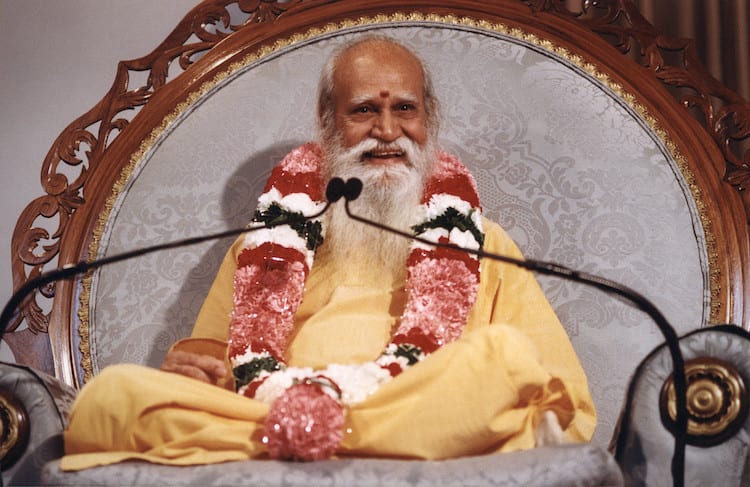There is a beautiful prayer of offering, or surrendering everything unto God, which explains our proper relationship with the Prakriti Dharma (the law of nature). It is usually repeated at the end of any practice: meditation, japa, puja, chanting, everything. Whatever you do, toward the end you can say this prayer:
Kayena Vaachaa Manasendriyair Vaa
Buddhyaatmanaa Vaa Prakriter Swabhaavaat
Karomi Yad Yad Sakalam Parasmai
Naraayanaayeti Samarppayaami
It means, “Oh Lord, the Cosmic One, I offer everything unto You. I offer all the actions done by the body, word, mind, senses, intellect, and the soul that have been due to the functioning of the qualities of the nature or Prakriter Swabhavat. Swabhava is the inherent nature of something; Prakriti is the One Lord in manifestation. All that you see as manifested has this Swabhava or its own nature, which is constantly tossed by the three qualities and uses the body to do things. So, whenever you feel dull, then you know that the tamas has taken over.
Then, sometimes you feel that you can’t sit quiet, you have to do something. You might even say, “I’m in this mood; I’ll never do it.” All of a sudden the mind has gone into a rajasic tendency. At that moment things get done. “Make hay while the sun shines!” When your mind is dull and lazy, however much you push, you find it difficult. At such times, you get annoyed. “Oh, I’ve been doing so much, so much, constantly. I’m not even appreciated, however much I do.” The mind goes on like that.A sane person will see that you are in a tamasic state, and he won’t force you too much.
Sometimes we get into an in-between, very balanced state. You feel like doing but not overdoing. You are neither dull nor too excited. It is a kind of sane, tranquil state. This is the sattvic state of mind.
Any of these attitudes can just happen, without even your wanting it. That is the proof that the mind is being tossed by these three gunas (qualities of nature). When there is wind, the unprotected flame flickers; when there’s no wind, it is steady. It is not just the motives of the mind alone. Our mind is part of the Cosmic Mind, part of Prakriti or nature. So, when the waves—the sattvic, rajasic and tamasic waves—come, it gets caught in that.
Shelter
We can develop the strength of mind to overcome these tendencies of influences. We can make an ordinary flickering lamp into a hurricane lamp. If there’s no shelter, if it’s not well protected, you have to always keep it indoors; you can’t even open the windows. The minute you open the windows, the flame goes out. But, if you shelter it with a nice chimney, you can take it even into the middle of a storm. That’s what is called a hurricane lamp, the flame is the same; it is well-sheltered. Properly sheltered, it can face the hurricane. The mind is like that. You can build up the strength of the mind. Then it can face all situations. All these movements are caused by the Prakriter Swabhava, the nature of the Prakriti, because everything is made out of these three gunas. If there are no changes in the gunas, everything is tranquil. That is the end of the cycle. In that pralaya, or equilibrium, they all stand still. So, in a way we need rajas and tamas as well as sattva to keep the world going. It is the rajas and tamas that create the entire show. If you read the seventeenth chapter of the Bhagavad Gita, you will see that everything is divided by these gunas.
Giving with the Gunas
Even charity is divided into these three categories. Once Rabbi Shlomo Carlebach told a story about the “holy miser.” He was not really a miser, but he looked like one. Why? Because he didn’t do anything to advertise what he did. He hid everything; he did all his good acts in secret. He didn’t want any praise for what he had done. That kind of charity is sattvic. The rajasic charity is when you give something with a good purpose—like building a church or a hospital—but you want recognition. During the consecration ceremony, you want people to come and take photographs of you and the building and put it in the headlines. It is charity, but it’s for name and fame—rajasic charity. Another way is to be lavish, spend plenty of money, buy a lot of food and drink and invite hundreds of friends. “Come on, drink as much as you want.” That’s tamasic. It doesn’t really help people to grow.
Meditation
Meditation can be tamasic, rajasic or sattvic also. If you meditate all by yourself without others even knowing that you are a Yogi, a meditator, people will think you are just an ordinary person. You simply go quietly when there is nobody around and just sit and meditate. That is sattvic. Please don’t think I am discouraging group meditation by saying this. That kind of meditation is very helpful, but we can do it with the proper attitude. Sri Ramakrishna used to say, if you are really a meditator, you will do it when everybody is asleep. You may even make others believe that you are going to sleep. Lie down; then, when the lights are off, get up quietly and meditate. If anybody turns on the light, you can immediately lie down again. Let people think you are just sleeping there. That is very sattvic and quiet. In rajasic meditation, you want everyone to see what you are doing. You might be feeling a little dull; but, if you see somebody coming, you sit up stiff and straight. When the person passes by, you sag again. It’s all for show. You do meditate, but you want others to say, “Oh, look how long she sits for meditation.” The tamasic meditation is when you sit and immediately go to sleep. You don’t even worry about what people think.
Equanimity
Excitement or rajas is a form of disturbance of the mind. The opposite, depression or tamas, is also a disturbance. What we want is the middle, the balance. Balancing is tranquility or sattva. That is what we call samadhi. Don’t think that samadhi means to sit and forget the body and mind and everything and sit like a rock for months. If that were the case, what would be the difference between you and a rock? Real samadhi is to keep the mind in samatwam. Samatwam means equanimity. “Samatwam Yoga uchyate: Equanimity is Yoga.” Samadhi is that samatwam. Keep the mind well-balanced under all conditions.
That is why I always give the example of a wonderful surfer. The one who surfs well is one who can serve well. If we learn to surf, we can learn to serve. Whatever kind of waves there are, the surfer still maintains his balance. He enjoys the challenging waves. A person who really knows how to surf will even be waiting for the biggest waves. Why? He or she knows how to balance. It is the same way with waves of life. One who knows that balance can be anywhere and everywhere.
(by Sri Swami Satchidananda, from the May 2008 IYTA Newsletter)



